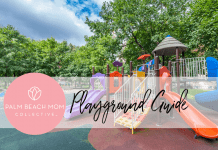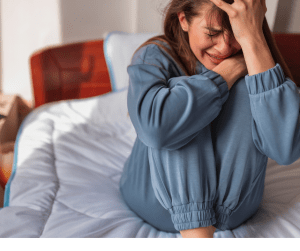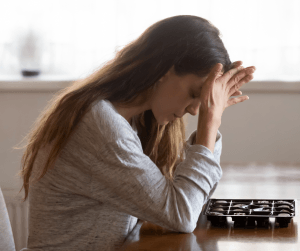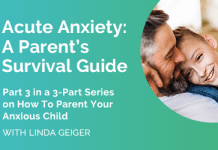We are excited to partner with the Anxiety Institute that is NOW in the Palm Beaches, located in Boca Raton, to bring you this great 3 part series.
Knowing when to seek help for your child or teen’s anxiety can be a tough call. At Anxiety Institute, the sole focus is treating clients with anxiety and related disorders with evidence-based techniques. Their team has the specialized training and experience to achieve superior outcomes.
Recognizing that your child is suffering from an acute anxiety disorder doesn’t happen overnight.
However, during the sometimes long and painful realization process, there can be “a-ha” moments when it becomes evident that professional help is your only option. For my husband and me, this moment occurred one morning when our formerly fun-loving, engaging teenager once more adamantly refused to leave his room to attend school. As we prepared to unleash the usual arsenal of incentives and threats, we looked at each other and came to an identical conclusion. Our child was not acting out of choice. No healthy 15-year-old would voluntarily spend his waking life barricaded in a tiny space, with only a computer and cell phone for company. His problem was not behavioral but medical, requiring medical intervention.
It takes self-awareness and a severe dose of humility to reach this conclusion.
We had experienced our share of behavioral problems with our older children and rated ourselves reasonably competent and experienced parents. But this experience was different. None of our prior parenting challenges had prepared us for the seismic shock of realizing we could no longer nurture our child – that every time-tested parenting technique was floundering or backfiring. As a loving parent, there are few feelings more distressing and frightening.
My Journey
I was in this situation a few short years ago. By recounting my journey, I hope to help you understand that many others have traversed this dark tunnel and that there’s light at the end.
This article should help you recognize the experience of having a child with acute anxiety. Further posts will explore some tools and techniques you can try and, just as vital, some ideas for your self-care during this process.
My first encounter with acute anxiety was daunting.
Several years ago, I was a helpless spectator as my third child, a convivial and sporty teenager, gradually withdrew from everyday life. He abandoned much-loved activities, disengaged entirely from the hubbub of teenage social and academic life, and retreated into the sanctuary of his bedroom. Simply speaking, he checked out.
Of course, every parent struggles periodically to decipher their child’s behavioral shifts or read their signals, perhaps dismissing them as passing phases of childhood development. But my son’s regression felt different from these typical growing pains. Although his separation from family and friends did not occur overnight, once he stumbled down this path of self-isolation, the pace of his disengagement quickened markedly. Within a few months, it felt as if I was losing him entirely. In addition, new physical symptoms such as stomach disorders, headaches, and eating disorders compounded his behavioral and attitudinal deterioration.
There appeared to be nothing I could do or say to help my son recover his zest for life or alleviate his worsening physical symptoms. As a result, my husband and I both experienced overwhelming feelings of inadequacy and frustration. Close friends and family, desperate to assist, were confused by his symptoms. They understood how he had changed but couldn’t fathom why.
Their reactions ranged from horror to anger, and their well-meaning advice at times felt judgmental and occasionally bordered on the absurd.
The guidance offered by local medical and educational institutions was at best superficial and at worst non-existent. Medical practitioners failed to diagnose the problem, and the educational establishment lacked the knowledge, resources, and wherewithal to help us develop a plan to manage his symptoms alongside his school commitments. Pursuing avenues for diagnosis and treatment was a lonely, frustrating, and heartbreaking endeavor.
This agonizing experience affected me deeply. In the eye of the storm, I understood that if I didn’t develop a plan, this experience could overwhelm our family.
We had to beat the problem, or it would defeat us. My child desperately needed treatment, or he would plunge further into gloomy isolation.
After a painstaking search, my son obtained the specialized treatment he needed after consultation with Dr. Dan Villiers, a specialist in anxiety disorder diagnosis and treatment.
Due to my own arduous journey, I felt compelled to guide other parents navigating the challenges of parenting their anxious children, find practical solutions to alleviate their pain, and help them find their children again.
But, more importantly, I had experienced the dearth of resources to help acutely anxious children like mine resume their energetic, promising young lives and mitigate the potential for a lifetime of mental health challenges. Consequently, in 2017, I co-founded Anxiety Institute with Dr. Dan Villiers.
Understanding Acute Anxiety
The first step in any treatment journey is understanding the problem.
Unfortunately, despite being recognized by many psychologists as one of the most common mental health disorders among children and adolescents, acute anxiety is misunderstood, misdiagnosed, and perhaps even neglected. Even the CDC addresses childhood anxiety broadly, focusing their analysis on those anxieties that affect very young children, such as separation anxiety, fears, and phobias. However, after working with experienced professionals in the field, I now comprehend the sheer scale of anxiety among youth.
By some estimates, between 9% and 32% of children and adolescents suffer from an acute anxiety disorder.
Moreover, specialized treatments for acute adolescent anxiety are challenging to locate and access. A recent article in The Journal of Child Psychology and Psychiatry concluded that “…very few children with anxiety disorders access evidence-based treatments, and there is an urgent need for widespread implementation of effective interventions.”
Many psychological conditions exist on a continuum, and anxiety is no exception.
The department of Health and Human Services (“HHS”) defines five types of anxiety disorders:
- Generalized Anxiety Disorder
- Obsessive-Compulsive Disorder
- Panic Disorder
- Post-Traumatic Stress Disorder
- Social Anxiety Disorder
All of these conditions (which often overlap) are sufficiently acute to require treatment. However, the crucial challenge with understanding whether your child has one or more of these conditions is identifying the difference between these disorders and the everyday anxiety of developing adolescents. This distinction is vital because the approach to supporting your child will be completely different.
Anxiety is a universal psychological response to a perceived threat.
Human beings are hard-wired to recognize perceived threats and generate a physical fight, flight, or freeze response. Furthermore, in children, these physical responses are usually exaggerated. Consequently, everyday anxiety is heightened by youth. In most cases, the anxiety results from the child not having encountered that particular threat before.
However, acute anxiety disorders are distinct. They begin when children respond to threats that are artificial, imaginary, or misunderstood. Even if they have encountered these threats before, anxious children experience a much more intense fight, flight, or freeze response that persists despite past experiences. The continual intense physiological response to these ‘synthetic’ threats becomes debilitating. Unaddressed, these perceived threats generate entrenched fears, which can be physical, such as arachnophobia, or abstract, such as fear of peer or parental judgment. Therefore, the acutely anxious child is over-responding physiologically to non-existent threats or fears.
The unique vulnerability of the adolescent brain compounds this problem.
According to the American Academy of Child and Adolescent Psychiatry (AACAP), adolescent brains process anxiety differently than adult brains. This is because the amygdala – the part of the brain responsible for immediate emotional reactions – develops before the frontal cortex, which regulates reasoning and helps us think before we act. As a result, adolescent behavior is guided more by the emotionally reactive amygdala than by the thoughtful, logical frontal cortex.
If your child has an acute anxiety disorder, their brain is easily triggered into a fight, flight, or freeze response.
When these children perceive danger, they may immediately panic, shut down or behave irrationally. Such exaggerated responses are commonly triggered by conditions that others would not consider threatening. By contrast, a non-anxious child’s brain will process the situation and use past experiences to decide their next action. In acutely anxious children, the response often becomes overwhelming and debilitating. Their minds have not adapted to integrate a more measured response, and it can cause the child to develop an anxiety disorder.
Early diagnosis and treatment of acute anxiety are essential because effective intervention can prevent the anxiety from becoming entrenched.
Left untreated, debilitating anxiety can detrimentally impact academic performance, emotional functioning, friendships, familial relationships, and physical health. In addition, an untreated acute anxiety disorder causes daily routines to become increasingly challenging, significantly affecting your child’s quality of life. Sadly, while untreated acute anxiety is debilitating during adolescence, it is also associated with life-long adverse mental health outcomes. With such high stakes, the crucial question remains: how do you decide if your child’s anxiety is acute?
Symptoms of Acute Anxiety Disorder
Inevitably, the symptoms of adolescent anxiety disorder vary.
Furthermore, the child’s unique familial or social circumstances can affect the severity significantly. A degree of heightened anxiety is inevitable in almost every teenager, given all the changes and uncertainties they are experiencing. Still, there is a range of symptomatic indicators around which most psychologists coalesce.
The American Academy of Child & Adolescent Psychiatry includes many of these in their analysis of anxiety and avoidance disorders:
- Feelings of constant nervousness, restlessness, or extreme stress
- Appearing dependent, withdrawn, or uneasy in social settings
- Physical symptoms such as muscle tension and cramps, stomachaches, headaches, pain in the limbs and back, or fatigue
- Blotching, flushing, sweating, hyperventilating, trembling, and startling easily
- Excessive shyness
- Avoidance of usual activities and refusal to engage in new experiences
- Engagement in risky behaviors such as drugs or sexual behavior
- Panic disorders with associated physical symptoms
- Irrational phobias
- School avoidance that leads to increased anxiety about school and social isolation
This list is not exhaustive, and of course, there’s no substitute for expert diagnosis, but absent that opportunity, if your child ticks several of these boxes, your child should be evaluated for an anxiety disorder. The question then becomes how best you can approach this debilitating condition and help your child. I will address these in my next article.
Conclusion
Supporting a child suffering from acute anxiety is a challenging endeavor.
However, it all starts with awareness of the condition. Hopefully, some of the indicators described in this article will allow you to understand if these apply to your child. As a parent, if you address acute anxiety as quickly as possible, treatment will permanently improve your child’s biological development. In addition, you will help them build skills that will empower them to achieve their full potential and lead a happy, healthy life.
My meandering journey from a bewildered mom to the co-founder of Anxiety Institute involved a great deal of learning. While the feelings of helplessness, anger and angst have long dissipated, I remember them vividly, and I have deep empathy for parents trying to nurture their acutely anxious child. I hope that this description of my journey and some of the insights I gleaned through working with leading professionals in the field will help and support you on your own journey.
About the Author:
Linda Geiger, CEO & Founder of the Anxiety Institute:
Linda Geiger is a highly experienced business and operations strategist with expertise in start-ups, both stand-alone and within complex organizations. Linda also has a significant background in financial turnaround for troubled companies, functions, and divisions. She brings a proven business track record in market strategy, marketing, and product development.
Linda is currently on the Board of Directors for a non-profit organization focused on leading-edge anxiety research, training, and education. She also served as an officer in the PTA and as a board member for over eight years for the Los Altos Educational Foundation (LAEF), a non-profit that funds enrichment programs and supports more effective learning environments through reduced class size.

















